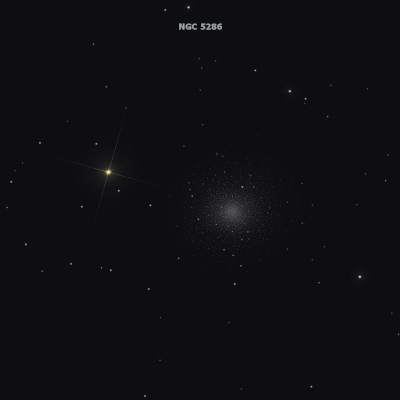
James Dunlop discovered NGC 5286 = D 388 = h3533 on 29 Apr 1826 with his 9-inch reflector and described "a bright exceedingly well-defined rather elliptical nebula, about 1' diameter, exceedingly condensed almost to the very edge, and gradually a little brighter to the centre. This is about 6' north of M Centauri - I have a strong suspicion that this is resolvable into stars." His position is 4.7' northeast of center. This one of the first few objects Dunlop discovered (same night as NGC 4945 and NGC 5128!)
John Herschel observed it on two sweeps, recording on 31 Mar 1835 "very bright; gradually much brighter to the middle; 2.5' or 3' diameter; resolved into 15th mag stars; has one star 12th mag S.f.; the centre near the edge. It is in the field with Brisbane 4618 a star of 6th mag." On his second sweep he reported, "bright; round; very gradually brighter to the middle; resolved; diam. 2'; stars of 16th mag; a bright star 7th mag in field."
200/250mm - 8" (7/13/91 - Southern Baja): moderately bright, fairly small, 2.5' diameter, round, evenly concentrated to a bright central region and a small bright core, mottled halo, one brighter mag 12 star on the SE side. On the verge of resolution although viewed at only 8° elevation. Mag 4.7 M Centauri with a mag 11 companion at 40" separation is located just 4.1' SE of the core!
300/350mm - 13.1" (2/20/04 - Costa Rica): at 105x this globular appeared very bright, moderately large and well-condensed with an intense, mottled core. At 200x, 15-25 14th magnitude stars popped in an out of view (some in chains), though only a handful were easily resolved, including a brighter star just east of the core. NGC 5286 is located 4' NW of yellow 4.7-magnitude M Centauri in the same high power field! It was easily visible in the 9x50 finder, though small. NGC 5307, a fairly bright planetary, lies 44' ENE.
Notes by Steve Gottlieb